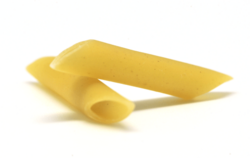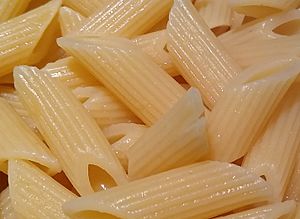Penne facts for kids

Penne lisce: the exterior of this pasta has a smooth surface.
|
|
| Type | Pasta |
|---|---|
| Place of origin | Italy |
| Variations | Penne lisce, penne rigate, pennoni, mostaccioli |
Penne is a popular type of pasta shaped like small tubes. These tubes have their ends cut at an angle, making them look a bit like the tip of an old-fashioned pen.
The word Penne comes from the Italian word penna, which means "feather" or "pen". This name was chosen because the pasta's shape was meant to look like the metal tip, called a nib, of a fountain pen.
How Penne Pasta Was Invented
Penne pasta is special because we know exactly when it was created! In 1865, a pasta maker named Giovanni Battista Capurro from San Martino d'Albaro, a town near Genoa in Italy, received a patent for his invention.
He created a special machine that could cut fresh pasta diagonally. This machine was amazing because it cut the pasta into the pen shape without squishing it. The pieces could be different sizes, from about 3 centimeters (1.2 inches) for mezze penne (half pens) to 5 centimeters (2 inches) for full penne.
Different Types of Penne
In Italy, you'll find two main kinds of penne:
- Penne lisce (pronounced LEE-shay) means "smooth penne". These pasta tubes have a smooth surface.
- Penne rigate (pronounced ree-GAH-tay) means "ridged penne". These have small ridges or grooves on their surface. The ridges help sauces stick better to the pasta!
There's also a wider version called Pennoni (pronounced pen-NOH-nee), which means "big quills". Sometimes, you might hear a similar pasta called mostaccioli. This name is often used by different pasta makers and can be either smooth or ridged.
Cooking Penne and Sauces
Penne is usually cooked until it's al dente. This Italian phrase means "to the tooth", and it describes pasta that is firm but still a little bit chewy when you bite into it. It's not soft or mushy.
Because of its tube shape and sometimes ridged surface, penne is great for holding all sorts of delicious sauces. Some popular sauces to enjoy with penne include:
- Pesto: A green sauce made from basil, pine nuts, garlic, cheese, and olive oil.
- Marinara sauce: A simple tomato sauce.
- Arrabbiata sauce: A spicy tomato sauce.
This spicy arrabbiata sauce has even been featured in famous Italian movies, like La Grande Bouffe by Marco Ferrari and Roma by Federico Fellini.
 In Spanish: Penne para niños
In Spanish: Penne para niños


